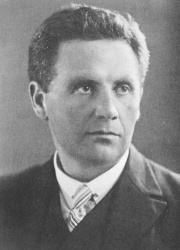Dirk Coster

Dirk Coster (5 October 1889 – 12 February 1950) was a Dutch physicist. He was a professor of Physics and Meteorology at the University of Groningen.
Coster was born in
Childhood and education
Coster grew up in Amsterdam in a large working-class family; he was the third child of Barend Coster, a
Academic career
From August 1922 until the summer of 1923, Coster worked in
After Coster returned from Copenhagen he became Hendrik Lorentz' assistant at the Teylers Museum in Haarlem, where he developed an X-ray spectrometer. In 1924 he was appointed at the University of Groningen, where he was the successor of Wander de Haas. At Groningen he started an active research program in X-ray spectroscopy.
In 1934 Coster became member of the Royal Netherlands Academy of Arts and Sciences.[2]
Later years
Coster was politically involved. In 1938 he traveled to
Publications
- Coster, D (July 1923). "Röntgenspektren und Bohrsche Atomtheorie". Naturwissenschaften. 11 (27): 567–577. S2CID 32356298.
- S2CID 120877752.
- Coster, D; doi:10.1038/111079a0.
- Coster, D; .
See also
References and further reading
- ^ Dirk Coster (1922). "Röntgenspectra en de atoomtheorie van Bohr" (PDF).
- ^ "D. Coster (1889 - 1950)". Royal Netherlands Academy of Arts and Sciences. Retrieved 19 July 2015.
- Scerri, Eric R. (March 1994). "Prediction of the nature of hafnium from chemistry, Bohr's theory and quantum theory". Annals of Science. 51 (2): 137–150. .
- ISBN 978-0-520-20860-5.
- Heisenberg's War: The Secret History of the German Bomb by ISBN 0-306-81011-5.
- No Time to Be Brief: A Scientific Biography of Wolfgang Pauli by ISBN 0-19-856479-1.
External links
- ^ Echternach, Eddy (2007-03-12). "'Nederlandse' Planetoïden". Retrieved 2007-03-27.
- H. Brinkman, Coster, Dirk (1889-1950), in Biografisch Woordenboek van Nederland.
- History of Hafnium
- Chemical & Engineering News article on the history of Hafnium by Eric R. Scerri
- Hafnium and Radioactive Tracers
